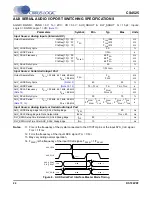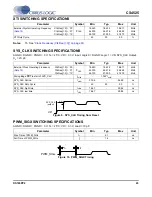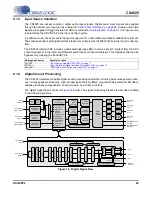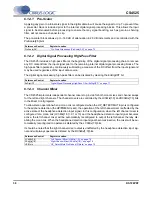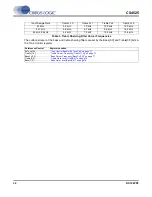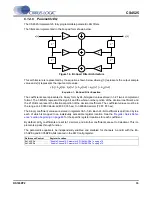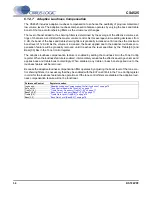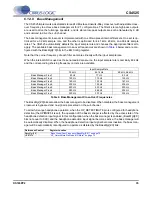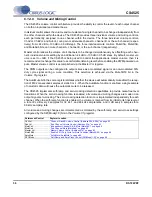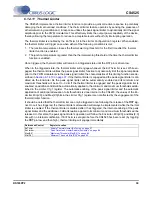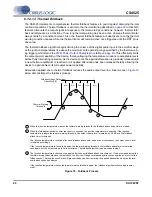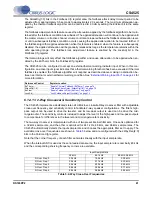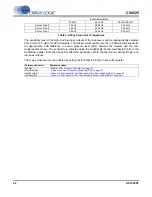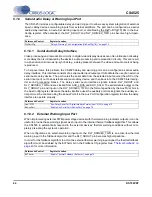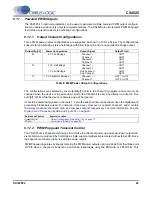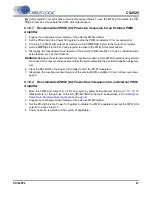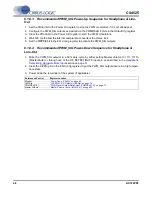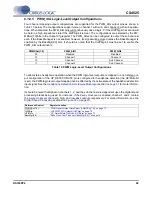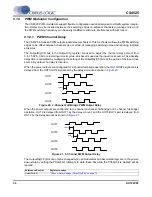
36
DS726PP2
CS4525
6.1.4.9
Volume and Muting Control
The CS4525’s volume control architecture provides the ability to control the level of each output channel
on both an individual and master basis.
Individual control allows the volume and mute state of a single channel to be changed independently from
the other channels within the device. The CS4525 provides three individual volume and muting controls,
each permanently assigned to one channel within the device. The three individual volume controls,
ChAVol, ChBVol, and SubVol, can gain or attenuate channel A, channel B, or the sub channel (respec-
tively) from +24 dB to -103 dB in 0.5 dB steps. The three individual mute controls, MuteChA, MuteChB,
and MuteSub bits, can mute channel A, channel B, or the sub channel (respectively).
Master control allows the volume of all channels to be changed simultaneously by offsetting each chan-
nel’s individual volume setting by an addi24 dB to -103 dB in 0.5 dB steps. By default, master vol-
ume is set to +3dB; if the CS4525 is being used to control the application’s master volume, then it is
recommended to change this value to a comfortable listening level before enabling the PWM powered out-
puts. Master volume control is accomplished via the Master Vol register.
The PWM outputs can be configured to output silence as a modulated signal or an non-modulated 50%
duty cycle signal during a mute condition. This selection is achieved via the Mute50/50 bit in the
Volume Cfg register.
The AutoMute bit in the same register dictates whether the device will automatically mute after the recep-
tion of 8192 consecutive samples of static 0 or -1. When the AutoMute function is enabled, a single sample
of non-static data will cause the automatic mute to be released.
The CS4525 implements soft-ramp and zero-crossing detection capabilities to provide noise-free level
transitions. When the zero-crossing function is enabled, all volume and muting changes are made on an
output signal zero-crossing. The zero-crossing detection function is implemented independently for each
channel. When the soft-ramp function is enabled, the volume is ramped from its initial to its final level at
a rate of ½ dB every 4 samples for 32, 44.1, and 48 kHz sample rates, and ½ dB every 8 samples for a
96 kHz sampling rate.
All volume and muting changes are implemented as dictated by the soft-ramp and zero-cross settings
configured by the SZCMode[1:0] bits in the Volume Cfg register.
Referenced Control
Register Location
ChXVol ................................
“Channel A and B Volume Control (Address 58h & 59h)” on page 83
SubVol.................................
“Sub Channel Volume Control (Address 5Ah)” on page 83
MuteChX .............................
“Independent Channel A & B Mute (MuteChX)” on page 84
MuteSub..............................
“Sub Channel Mute (MuteSub)” on page 85
Master Vol ...........................
“Master Volume Control (Address 57h)” on page 82
Mute50/50 ...........................
“Enable 50% Duty Cycle for Mute Condition (Mute50/50)” on page 80
AutoMute.............................
“Auto-Mute (AutoMute)” on page 80
SZCMode ............................
“Soft Ramp and Zero Cross Control (SZCMode[1:0])” on page 80

